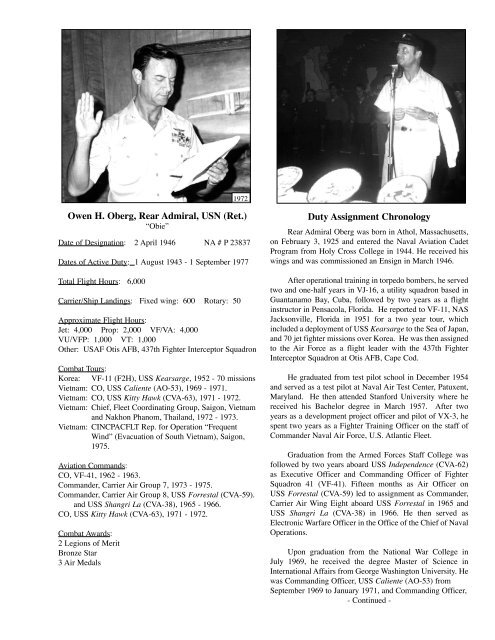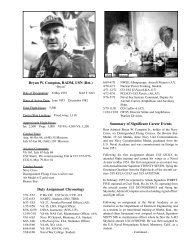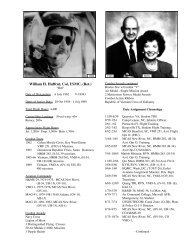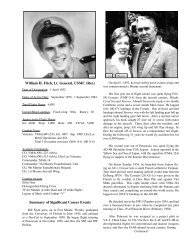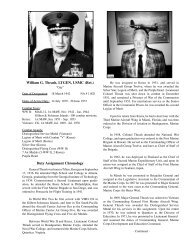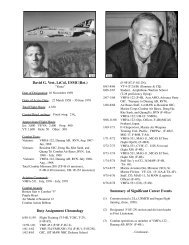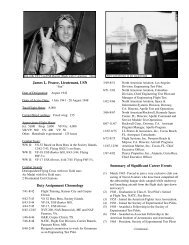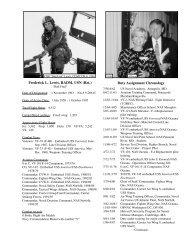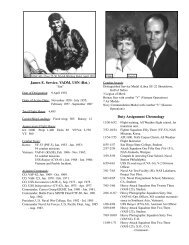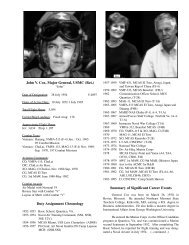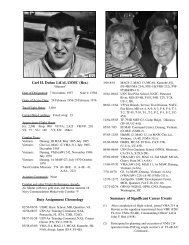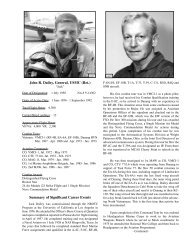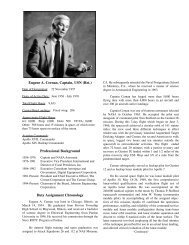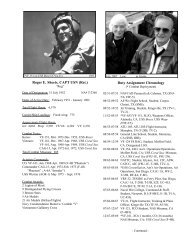Owen H. Oberg, Rear Admiral, USN (Ret.) Duty Assignment ...
Owen H. Oberg, Rear Admiral, USN (Ret.) Duty Assignment ...
Owen H. Oberg, Rear Admiral, USN (Ret.) Duty Assignment ...
Create successful ePaper yourself
Turn your PDF publications into a flip-book with our unique Google optimized e-Paper software.
<strong>Owen</strong> H. <strong>Oberg</strong>, <strong>Rear</strong> <strong>Admiral</strong>, <strong>USN</strong> (<strong>Ret</strong>.)<br />
“Obie”<br />
Date of Designation: 2 April 1946 NA # P 23837<br />
Dates of Active <strong>Duty</strong>: 1 August 1943 - 1 September 1977<br />
Total Flight Hours: 6,000<br />
Carrier/Ship Landings: Fixed wing: 600 Rotary: 50<br />
Approximate Flight Hours:<br />
Jet: 4,000 Prop: 2,000 VF/VA: 4,000<br />
VU/VFP: 1,000 VT: 1,000<br />
Other: USAF Otis AFB, 437th Fighter Interceptor Squadron<br />
Combat Tours:<br />
Korea: VF-11 (F2H), USS Kearsarge, 1952 - 70 missions<br />
Vietnam: CO, USS Caliente (AO-53), 1969 - 1971.<br />
Vietnam: CO, USS Kitty Hawk (CVA-63), 1971 - 1972.<br />
Vietnam: Chief, Fleet Coordinating Group, Saigon, Vietnam<br />
and Nakhon Phanom, Thailand, 1972 - 1973.<br />
Vietnam: CINCPACFLT Rep. for Operation “Frequent<br />
Wind” (Evacuation of South Vietnam), Saigon,<br />
1975.<br />
Aviation Commands:<br />
CO, VF-41, 1962 - 1963.<br />
Commander, Carrier Air Group 7, 1973 - 1975.<br />
Commander, Carrier Air Group 8, USS Forrestal (CVA-59).<br />
and USS Shangri La (CVA-38), 1965 - 1966.<br />
CO, USS Kitty Hawk (CVA-63), 1971 - 1972.<br />
Combat Awards:<br />
2 Legions of Merit<br />
Bronze Star<br />
3 Air Medals<br />
1972<br />
<strong>Duty</strong> <strong>Assignment</strong> Chronology<br />
<strong>Rear</strong> <strong>Admiral</strong> <strong>Oberg</strong> was born in Athol, Massachusetts,<br />
on February 3, 1925 and entered the Naval Aviation Cadet<br />
Program from Holy Cross College in 1944. He received his<br />
wings and was commissioned an Ensign in March 1946.<br />
After operational training in torpedo bombers, he served<br />
two and one-half years in VJ-16, a utility squadron based in<br />
Guantanamo Bay, Cuba, followed by two years as a flight<br />
instructor in Pensacola, Florida. He reported to VF-11, NAS<br />
Jacksonville, Florida in 1951 for a two year tour, which<br />
included a deployment of USS Kearsarge to the Sea of Japan,<br />
and 70 jet fighter missions over Korea. He was then assigned<br />
to the Air Force as a flight leader with the 437th Fighter<br />
Interceptor Squadron at Otis AFB, Cape Cod.<br />
He graduated from test pilot school in December 1954<br />
and served as a test pilot at Naval Air Test Center, Patuxent,<br />
Maryland. He then attended Stanford University where he<br />
received his Bachelor degree in March 1957. After two<br />
years as a development project officer and pilot of VX-3, he<br />
spent two years as a Fighter Training Officer on the staff of<br />
Commander Naval Air Force, U.S. Atlantic Fleet.<br />
Graduation from the Armed Forces Staff College was<br />
followed by two years aboard USS Independence (CVA-62)<br />
as Executive Officer and Commanding Officer of Fighter<br />
Squadron 41 (VF-41). Fifteen months as Air Officer on<br />
USS Forrestal (CVA-59) led to assignment as Commander,<br />
Carrier Air Wing Eight aboard USS Forrestal in 1965 and<br />
USS Shangri La (CVA-38) in 1966. He then served as<br />
Electronic Warfare Officer in the Office of the Chief of Naval<br />
Operations.<br />
Upon graduation from the National War College in<br />
July 1969, he received the degree Master of Science in<br />
International Affairs from George Washington University. He<br />
was Commanding Officer, USS Caliente (AO-53) from<br />
September 1969 to January 1971, and Commanding Officer,<br />
- Continued -
USS Kitty Hawk (CVA-63) from April 1971 to June 1972.<br />
On 10 June 1972, he reported for duty as Chief, Fleet<br />
Coordinating Group, Saigon, which subsequently moved to<br />
Nakhon Phanom, Thailand, where he served until 14, June<br />
1973. After serving as Commander Carrier Group Seven<br />
from 21, July 1973 until 7, February 1975, he reported to<br />
Pacific Fleet Headquarters as Deputy Chief of Staff for<br />
Operations and Plans, and acted as the Commander-in-Chief's<br />
representative in Saigon during Operation “Frequent Wind”<br />
(the evacuation of South Vietnam).<br />
<strong>Rear</strong> <strong>Admiral</strong> <strong>Oberg</strong>'s promotional history is: Lieutenant<br />
(junior grade) on 1, April 1949; Lieutenant on 1, July 1952;<br />
Lieutenant Commander on 1, December 1957; Commander<br />
on 1, July 1962; Captain on 1, July 1967; and <strong>Rear</strong> <strong>Admiral</strong><br />
on 1, June 1972. His awards include two Legions of Merit,<br />
Bronze Star, three Air Medals, and numerous unit, service<br />
and foreign decorations.<br />
He completed his tour at Pacific Fleet Headquarters<br />
in September 1977 and retired from the U.S. Navy to pursue<br />
a career in industry,. He was first a program manager<br />
for Hughes Aircraft Company, Los Angeles until July 1981<br />
and then Product Line Manager of Cubic Corporation, San<br />
Diego, California. He retired from industry in 1987 and now<br />
resides in a grove in Pauma Valley, California with his wife<br />
of 47 years, the former Margaret L. <strong>Owen</strong>s of Wyandotte,<br />
Michigan. They have four children, Sandra, <strong>Owen</strong>, Michael<br />
and Elizabeth and eight grandchildren.<br />
Summary of Significant Career Events<br />
(1) Graduate of the Navy Test Pilot School, Naval Air Test<br />
Center, Patuxent River, MD.<br />
(2) Sidewinder missile Project Officer, VX-3, NAS<br />
Atlantic City, NJ., 1957-58.


